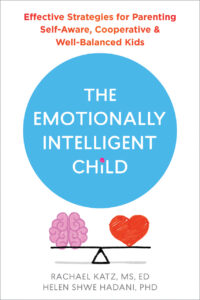The Emotionally Intelligent Child by Rachael Katz, MS, Ed and Helen Shwe Hadani, PhD (Book Excerpt)
 Executive Function in Social and Emotional Development
Executive Function in Social and Emotional Development
EF is a powerful predictor (in some cases, even better than IQ scores) of children’s success in school and beyond.[i],[ii],[iii] EF has received increased attention from the popular press and academic researchers because components of EF are essential for school achievement and for behaviors that entail teamwork, leadership, and social awareness. EF helps us plan and prioritize tasks to balance workflow, think about the role that others will play to complete tasks, and set and achieve goals. We are required to use EF skills in almost everything we do—when learning, interacting with others, doing something time-bound, and more.
The core components of EF include self-control, cognitive flexibility, and working memory. An additional component that is important for social-emotional development is focus or attention.[iv] When we think about EF, we tend to think about it in relation to children’s academic learning; however, we have come to see that this view is too narrow. In fact, research suggests an important link between EF skills and understanding emotions.[v] We see that young children are continually problem solving during social interactions. EF skills can be described in the following ways. Have you seen your child using these skills?
Inhibition or self-control helps your child make decisions—hopefully, smart ones—by resisting impulses to do something that they would later regret (like not pulling the cat’s tail, even though it looks fluffy, to avoid getting scratched). In social settings, this requires your child to resist acting according to their first instinct because that action may impact someone else negatively. For example, imagine that 5-year-old Edward’s 3-year-old sister picked his favorite red toy car out of the basket. Instead of grabbing the car out of her hand, he was able to negotiate a sharing plan with her. His mom noticed his patience and told him he should feel proud of how he responded. Edward beamed from the positive reinforcement, noting the value of self-control.
Cognitive flexibility—sometimes referred to as “thinking outside the box”—is closely linked with creativity and problem solving, and it allows your child to consider different perspectives and strategies (such as transforming your kitchen stool into a tree house for teddy bears). This requires adjusting to the demands of relationships, which, by nature, are constantly shifting. Jessica and Todd (both 2½ years old) were playing with a toy xylophone together. Jessica struck the keys with the mallet and then passed it to Todd so he could have a turn. Jessica waited for Todd to pass the mallet back, but he didn’t; he would not share. Jessica’s mom watched her daughter navigate the situation. First, Jessica looked surprised. After a moment, she picked up a spoon from the play kitchen and used it in place of the mallet. She smiled at Todd, who smiled back. Jessica then traded the spoon for the mallet to give Todd a try. Jessica’s mom was impressed by her daughter’s thinking; she’d handled the social situation with creativity and a smile.
Working memory allows your child to hold and mentally manipulate information in their mind and make connections between seemingly unrelated things (like keeping track of the names of their Pokémon action figures). It can be used to remember instructions when working with others to complete a task. For instance, Daniel and Brian (both 6 years old) made a plan to build a bridge with blocks for their race cars. Pretending to be engineers, they sketched out their idea. Daniel divided the tasks between them, and the boys began building. After working for some time independently, Daniel went to see how Brian’s part of the bridge was coming along. Much to Daniel’s surprise, Brian was not following the plan and had started building a house with his blocks. Daniel was furious and yelled, “What are you doing? We had a plan to build a bridge!” Brian was too embarrassed to tell Daniel that he didn’t remember all the steps needed to complete his part.
Focus or attention is critical for achieving both short- and long-term goals (such as tuning out the distractions of a buzzing light and a crying baby sister to focus on homework). This is essential to observe social interactions and anticipate how someone might respond. Maggie (5 years old) watched her grandma struggle to make school lunches for her brothers and sisters. Maggie asked how she could help. Her grandma was touched and relieved to have someone help her. Maggie’s grandmother placed an extra cookie in her lunch.
The beloved children’s television show Sesame Street dedicated an entire season to promoting EF—in particular, self-control—by featuring Cookie Monster and his insatiable love of cookies. Rather than just eating every cookie in sight, Cookie Monster had a new mantra: “Me want it, but me wait.” Dr. Rosemarie Truglio, the program’s senior vice president for curriculum and content, made the important point that the show targets preschool children, which is the best time to promote EF skills because they are primed to learn them at that stage of development.[vi] Building your child’s EF skills in the early years yields great payoffs down the road. And one of the best ways to start teaching your young child EF skills is to model them. Consider these questions as you think about how to support your child’s growing EF skills:
- Think about a time when you were particularly taken aback by something your child did. Which EF component was dominant in what you observed?
- In figure 3, which aspect of EF seems most challenging for your child when interacting with others?
- In your own actions, which EF components are readily on display for your child to see?
- Is there a particular EF component that is more challenging for you to apply in social situations? Compare this with your child’s tendencies, appreciating the strengths in both of you while acknowledging potential areas for improvement.
[i] Allan, N. P., L. E. Hume, D. M. Allan, A. L. Farrington, and C. J. Lonigan. 2014. “Relations Between Inhibitory Control and the Development of Academic Skills in Preschool and Kindergarten: A Meta-Analysis.” Developmental Psychology 50: 2368–2379.
[ii] Duckworth, A. L., and M. E. Seligman. 2005. “Self-Discipline Outdoes IQ in Predicting Academic Performance of Adolescents.” Psychological Science 16: 939–944.
[iii] Moffitt, T. E., L. Arseneault, D. Belsky, N. Dickson, R. J. Hancox, H. Harrington, R. Houts, R. Poulton, B. W. Roberts, S. Ross, and M. R. Sears. 2011. “A Gradient of Childhood Self-Control Predicts Health, Wealth, and Public Safety.” Proceedings of the National Academy of Sciences 108: 2693–2698.
[iv] Galinsky, E. 2010. Mind in the Making: The Seven Essential Life Skills Every Child Needs. New York: Harper Studio.
[v] Martins, E. C., A. Osório, M. Veríssimo, and C. Martins. 2016. “Emotion Understanding in Preschool Children: The Role of Executive Functions.” International Journal of Behavioral Development 40(1): 1–10.
[vi] Mustich, E. September 13, 2013. “Cookie Monster Learns to Self-Regulate So Kids Can Too.” Huffington Post. https://www.huffpost.com/entry/cookie-monster-self-regulation-sesame-street-rosemarie-truglio_n_3910334.
 ABOUT THE AUTHORS
ABOUT THE AUTHORS
Rachael Katz, MS, Ed, teaches social and emotional learning skills to parents and children. With more than twenty-five years teaching experience, she is former head of the Discovery School at the Bay Area Discovery Museum, and head of social and emotional learning for Early Years at Dulwich College Beijing.
Helen Shwe Hadani, PhD, is currently a fellow at the Brookings Institution where she conducts policy-focused research on the benefits of playful learning in both formal and informal contexts. She is former director of research at the Bay Area Discovery Museum.
Click HERE to read about the book.
Tags: executive functioning















